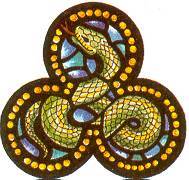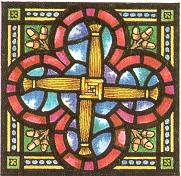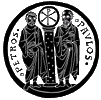The son of a Roman official named Capurnius, Patrick probably was born in Wales. At the age of sixteen he was captured by raiders [Vikings?] and later sold to an Irish chieftain named Milchu. Most of his several years of slavery were spent herding sheep on Slemish Mountain in County Antrim. One night he had a dream in which a voice told him to find a ship which would be waiting to take him to his own country. After a journey of 200 miles on foot, he found the ship, and eventually he was able to return to his family.
On another occasion, in a dream he was told to go back to Ireland. Somehow he ended up in France, where he studied under Saint Germanus at Auxerre. His subsequent mission to Ireland was approved because of the death of Saint Palladius, who had been sent to serve the Irish believers in the year 431. Therefore, Saint Patrick's voyage to Ireland must have taken place in 432. He landed on the shores of Strangford Lough, he made a convert of the local chief, Dichu. This Dichu gave Saint Patrick a barn in Saul, County Down, for his first church.

After a time Patrick made his way to the Hill of Tara, County Meath, seat of the high king of Ireland. Having arrived on Holy Saturday, he lit a Paschal fire on the nearby Hill of Slane. When the druids saw the fire, they warned King Laoghaire that he must extinguish it or it would burn forever. He summoned Patrick to Tara, and on the way he and his followers chanted the hymn known as "The Lorica," or "Saint Patrick's Breastplate." Laoghaire was so impressed by the saint that he gave him permission to conduct his missionary work throughout the realm. But the king remained a pagan.
The Life of Patrick, written two centuries later by Muirchu, tells of a contest of druid magic versus Christian miracle in which Laoghaire's druids had to concede victory to Saint Patrick. Perhaps it was this contest that so impressed King Loaghaire with him.
Having traveled widely in Ireland, everywhere making converts and establishing new churches, Saint Patrick finally made Armagh his headquarters. On one occasion he spent forty days of the Great Fast on a mountain in County Mayo, which is now called Croagh Patrick. There he was harassed by demons in the form of blackbirds, which clustered so densely that the sky was black. But Patrick continued to pray and to ring his bell until the demons were dispersed. Thereupon an angel appeared to tell the saint that all his petitions for the Irish people would be granted, and that they would retain their Christian faith until Judgment Day.
The traditions surrounding the life of Saint Patrick include his driving the snakes out of Ireland, and of his using the shamrock to teach the people about the Holy Trinity. Saint Patrick's writings were done in his later life. His Confession, an answer to criticisms of his mission in Ireland, is a moving revelation of his vocation and of the divine guidance he received in dreams.
Irish history says that Saint Patrick reposed in 493, but other historians say 461. [That's a difference of 32 years! One would think the estimates would be closer. — Ed.] According to tradition, he reposed at Saul and was buried at nearby Downpatrick.
Adapted from Celtic Saints by Wallace Martin. (San Francisco: Chronicle Books, 1995, pp. 9–11.
Saint Brigid of Kildare Saint Brigid, a contemporary of Saint Patrick, is probably the second best known Irish saint. Again, as in the case of Saint Patrick, not much is known about her life. The Life of Brigid, by Cogitosus, was written about a century after her repose. This writer's main interest was telling about her many miracles. Some think that she was born in County Kildare in about 457, but local tradition has it in Faughart, County Louth. Her parents, Dubtach and Brocseach, might have been members of noble families. Another account says that Brigid's mother was a slave in Dubtach's household. Brocseach was a Christian, but Dubtach probably did not convert until later in his life.Brigid was known for her generosity to the poor. For example, as a child she once gave away her mother's whole store of butter. Later [probably after being made aware of her mother's concern — Ed.], she prayed and the store of butter was miraculously renewed.
When Brigid rejected her father's choice of a husband for her, she took up the monastic life. She took vows before Saint Mel, the abbot and bishop of Longford. It is said that the bishop mistakenly consecrated her a bishop! [Such a misunderstanding might have occurred if she was immediately made an abbess. Since the story goes on to say that she went about seeking land for her community, it is implied that she was the founder and abbess. — Ed.] Anyhow, she asked the King of Leinster for only as much land as her cloak would cover. The cloak miraculously spread over the whole of the Curragh.
As in many countries of the world, Christianity in Ireland superimposed itself on the Celtic tradition. Pagan worship sites became Christian worship sites. Brigid's feast day of January 19/February 1 was also the pagan festival of spring. Brigid, meaning "exalted one," was a general name for Irish goddesses. The name "Kildare" means "church of the oak," and the "sacred" fire there probably burned for centuries into the Christian era. Just as in the time of the prophets of old, the Christian Church had to be ever vigilant against the people reverting to pagan practices, including idolatry.
Brigid traveled by chariot throughout Ireland, carrying on Saint Patrick's work of conversion, but there is no evidence that they ever met. Through her intercession lepers were cured, the dumb spoke, and many other kinds of healings occurred. She is said to have turned water into ale and stone into salt. She had that special rapport with animals often observed in saints She obtained the release of captives.

Perhaps her best-known miracle is of her visit to a dying pagan chieftain. While she prayed, she plaited rushes into a. cross. Having heard her account of our Savior's Crucifixion and Resurrection, he was baptized before he died. It is still customary on January 19/February 1 to plait Saint Brigid's crosses which are used as holy objects to protect a household in the year ahead.
Saint Brigid reposed in about 525. A common greeting in the Irish language is the prayer "Mary and Brigid be with you." Her "popularity" as a saint is not limited to Ireland. She is revered in many countries. One legend has it that the medieval Knights of Chivalry chose Saint Brigid as their patroness, and that it was they who first called their wives "brides."
Adapted from Keltic Saints, by Martin Wallace (San Francisco: Chronicle Books, 1995), pp. 13–15.
Saints Patrick and Brigid, intercede for us!
